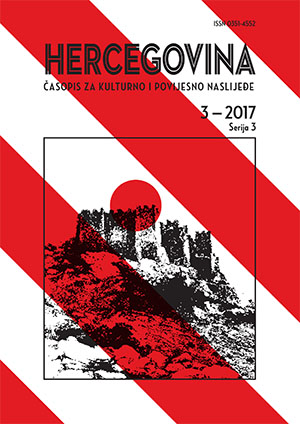HERCEG STJEPAN VUKČIĆ KOSAČA I POLIMLJE
Herzog (Duke) Stjepan Vukcic Kosaca and Polimlje
Author(s): Marijan PremovićSubject(s): History, 15th Century
Published by: Filozofski fakultet Sveučilišta u Mostaru
Keywords: Stjepan Vukcic Kosaca; Middle Ages; Polimlje; political situation; border; economy.
Summary/Abstract: This paper will review the historical facts about Polimlje(Middle and Lower) at the time of Herzog Stjepan Vukcic Kosaca. The term Polimlje refers to the space of medieval parishes: Black Stone (the territory of the municipality of Prijepolje, Serbia) and Dabra (includes the municipality of Priboj in Serbia and Rudo in Bosnia and Herzegovina).The most important document about the settlements and fortresses of this area is the Charter of Herzog Stjepan Vukcic Kosaca which was twice released by Aragon and Naples King Alfonso V of Aragon (1444, 1454) and one by German "Roman" Emperor Friedrich III of Habsburg (1448). According to the plans of towns in these charters,the defense system of the Herzog Stjepan's area and all fortified towns with military crews which were protecting important roads and passes in the Herzog's authority can be seen. A special review is given to towns and fortresses: Milesevac, Kovin, Ostrik, Klek, Severin and Hrsovac.Based on archival documents, diplomatic materials,and relevant historical literature we show the boundary between Kosaca and despotate. In October 1448, Sjepan takes the title of Herzog. In the charter dated 6 April 1449,especially prominent is the cult of Saint Sava. The Herzog emphasized through Mileseva monastery (with the relics of Saint Sava) his countries' relationship with the old Serbian state and dynasty of Nemanjic. The title was showing Saint Sava as protector of Kosaca and their possessions.After this title 'Herzog' the country was named Herzegovina,and that name has been preserved until today. Prijepolje in Polimlje had a special role in the caravan traffic: it became the most important commercial and economic center. According to the dynamics of the station wagon ride in Polimlje there were two groups, the first included those that were active at the end of XIV and the first two decades of the XV century: Bukovica, the church of St. Nicola in Banja, Ivanje, Ravno and the church Mili.The second group included Breza and Drenova that havereached their peaks in the 20-ies and 30-ies of the XV century. In the early summer of 1465 the vicar of Sultan Isa Beg Ishakovic began with the conquest of Herzegovina.On this occasion Prijepolje, Milesevac and Lower Polimlje were occupied.
Journal: Hercegovina. Časopis za kulturno i povijesno naslijeđe (Do 2018)
- Issue Year: 2017
- Issue No: 3
- Page Range: 99-115
- Page Count: 17
- Language: Croatian

